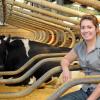-
Antibiotic Use in Agriculture: Antibiotics have been widely used in agriculture for several purposes, including promoting growth in livestock and preventing and treating disease in animals. They are also used in aquaculture and plant agriculture.
-
Emergence of Resistance: The overuse and misuse of antibiotics in agriculture have contributed to the emergence of antibiotic-resistant bacteria in animals, soil, and water. Resistant bacteria can spread to humans through food consumption, direct contact with animals, or environmental contamination.
-
One Health Approach: AMR in agriculture is linked to human health through the One Health concept. Resistant bacteria can transfer between animals, humans, and the environment, making it a complex and interconnected issue.
-
Food Safety Concerns: Resistant bacteria can contaminate food products, posing a risk to consumers. Consuming antibiotic-resistant pathogens can limit treatment options for infections in humans.
-
Environmental Impact: The use of antibiotics in agriculture can lead to the release of residues into the environment. This can contribute to the development of resistance in environmental bacteria and impact ecosystems.
-
Regulatory Efforts: Many countries have introduced regulations to control the use of antibiotics in agriculture. These regulations aim to promote responsible use and limit the emergence of resistance.
-
Alternatives to Antibiotics: In response to AMR concerns, there is growing interest in developing and promoting alternative strategies in agriculture, such as probiotics, prebiotics, and vaccines, to reduce the reliance on antibiotics.
-
Farm Animal Welfare: In some cases, antibiotics have been used to compensate for poor animal welfare conditions. Improving animal welfare practices can help reduce the need for antibiotics.
-
Research and Surveillance: Ongoing research and surveillance efforts are essential for monitoring the prevalence of AMR in agriculture and understanding the mechanisms of resistance.
-
Education and Training: Farmers and agricultural professionals need education and training on responsible antimicrobial use, including proper dosage, administration, and withdrawal periods.
-
Global Collaboration: Addressing AMR in agriculture requires global collaboration, as resistant bacteria do not respect borders. International organizations, governments, and the agricultural industry need to work together to develop and implement effective strategies.
Please share information, tools and resources related to antimicrobial resistance.
This summary was written with the help of Open AI's ChatGPT. If you would like to edit or add to this summary, click 'join page'.


